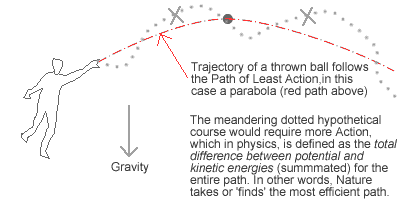It all adds up - the principle of Least Action
Synopsis
Resonant Scale Structures could form from a combination of Least Action principles acting in synchrony and synergy and, possibly, in higher dimensions—certain points or paths emerge as 'resonant' and reflect the whole and these are reinforced, whereas others that are less resonant and less reflective of 'the whole' dissipate (or contribute as 'partials' which point to, and together 'add-up to', the more resonant paths, points and planes).
Least Action
Least Action has a special meaning in physics. It's a very simple idea but with far-reaching consequences. Basically it states that Nature always finds the most efficient course from one point to another. (It seems it might be somehow hardwired into numbers and physical law in a way we still do not fully understand, but the effects of which have been well-documented and established experimentally time and again—the orbits of planets, the path of a thrown ball, the path of a photon of light—all these will follow (of their own 'volition' it seems) paths of least action (defined as paths in which the total energy needed to get from point A to point B is minimised).
The relation between 'energy' and 'action', as defined
At the beginning of the 21st century, it seems we are still lumbered with a rather inadequate and tired old 'lexicon of terms'—the legacy of bygone eras and paradigms—to describe Nature's behaviour and properties. Words like 'energy' are bandied about as if we know exactly what we mean (when we do not), and these have even been embodied symbolically in many famous equations of physics. (Perhaps there exist more refined concepts.) Among these old concepts are the familiar definitions of potential energy and kinetic energy. But if, as Einstein discovered, all motion (speed) is relative, and if all positions are relative, it appears that these concepts of 'potential and kinetic energy' need to be, in some sense, qualified.
Nevertheless these terms (potential and kinetic energy) to which we have become accustomed and which still perhaps retain some utility even if they are rather like the wooden wheels of a buggy for getting us to conclusions about things at least on a local scale) are here combined in this interesting concept of Least Action. In my view, Least Action is curiously more powerful as a concept than the concepts of energy it entails (potential and kinetic energy) and perhaps one day the principle of Least Action will be understood in simpler visual mathematical terms and patterns that do not require this 'qualification' mandated by Einstein's theory.
The Least Action paradigm shift
There is a fundamental difference in the way Least Action interprets the orbits of planets for example: not as a moment-by-moment thing (as in the Calculus), but as a holistic consideration and summation of all possible paths. The net result of this 'summing up' of all possible paths is manifest as the orbit of the planet. Nearby or adjacent possible paths reinforce one another and reach a maximal resonance precisely at the path of least action; the more distant ones cancel each other out.
Science historian (J. Gleick, 1993) states:
| It is impossible for a physicists to talk about the principle of least action without inadvertently imputing some kind of volition to the projectile. The ball seems to choose its path. It seems to know all the possibilities in advance. |
|
Least Action 'precipitating out' in the formation of Resonant Scale Structures
In the book Principles of Nature: towards a new visual language (Roberts, 2003), the natural formation of and attraction towards Resonant Scale Structures is described as follows:
| Nature's finding of the best path as outlined above, the path which is most efficient, the path of least action , is, I believe, very much related to the natural ‘gravitation’ towards resonant scale structures . All possible divisions of a scale make themselves felt in the outcome. No potential division or scale structure goes uncounted. The summing of all possibilities yields scale structures of 'least action', of greatest efficiency. These are the resonant scale structures . The fact that they represent the summing of all possible scale structures of a given domain reflects their connection to the whole and helps to explain their resonance. Just as in least action, in which time is considered globally (all at once) with a bird's-eye perspective, so resonant scale structures arise through a multiple integrative interactive process in which past and future are equal players.... The resonant scale structures are the emergent forms. They are the result of global action and interaction, the residue, the crystal lattice, the clumpy outworkings of universal connection. They are the structures of best fit and greatest efficiency and resonance. |
|
| back to top |
next > |
